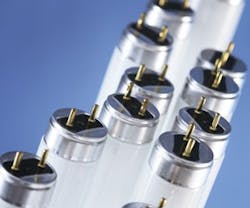Manufacturing grinds to a halt this year for 100W incandescent bulbs and the most common type of T12 lamps, representing another step in federal efforts to gradually remove inefficient lighting technologies from the marketplace.
Both technologies are still available, but as production slows to a halt, availability will drop quickly. To beat the shortage, look at your update options sooner rather than later.
Countdown to Relamping
After the Energy Policy Act was updated in 2005, the DOE gradually began rolling out efficiency standards for general service fluorescent lighting, with production to cease on all lamps that can’t meet the requirements by July 14, 2012. The most commonly used T12 magnetic ballasts disappeared in July 2010 as the regulations were phased in.
“The typical office building is full of T12s. They’re all over the country,” says Katrin M. Mehler, managing partner and president of LUXADD, an international lighting solution provider and developer. “They’re also used in two-lamp solutions in parking garages and warehouses, and they’re often found in hotels, government buildings, and schools.”
Incandescent lighting is affected by the Energy Independence and Security Act of 2007 (also known as the Clean Energy Act), which mandates at least 27% greater efficiency of light bulbs by 2014.
Compact fluorescents, LEDs, and some halogens meet this standard, but many traditional incandescents don’t, though some lighting manufacturers have introduced more efficient versions that meet the standard to satisfy consumer demand for incandescent lighting’s trademark warm-colored glow.
The phase-out of traditional 100W incandescent bulbs began in January; 75W bulbs will follow in 2013, with 60W and 40W to go in 2014.
You may be able to find replacement tubes and bulbs in the short term after they’re no longer manufactured, but upgrading is inevitable. Fortunately, solutions are quickly surfacing.
Five Retrofit Tips
It’s easy to retrofit screw-base incandescent lamps in most cases, Mehler says. Products made to replace Edison lamps are self-ballasted, so it’s only a matter of screwing in the new bulb. Linear fluorescent lighting, however, presents a bigger challenge. Try these tips from lighting experts to weigh your options.
- See a sample first. “Don’t do anything until you see a mockup of the proposed solution,” says Gary Trott, vice president of marketing development for manufacturer Cree Lighting. “If you have a building with 200 lights, have the potential supplier install a conference room so you can see what it looks like. Seeing is believing.”
- Look for labels. The ENERGY STAR logo will mark lamps that meet their efficiency standard. “If a screw-in lamp has an ENERGY STAR label on it, that’s a first cut,” Trott explains. “If it doesn’t have that label, I would not consider it.” Make sure it also has a UL listing, Mehler recommends.
- Examine control options. Tie the new lighting to motion or occupancy sensors whenever possible, as well as products that dim lamps in response to natural light. “The most efficient lighting interacts with the environment,” advises Karl Williams, vice president of energy solutions for Rexel, a lighting distributor.
- Evaluate retrofit kits. These products allow you to change a T12’s ballast and the holders that keep the lamp in place, enabling it to accommodate more efficient linear lighting.
- Downsize lamp usage. Retrofit three-lamp T12 fixtures to accept two T8s, which will give you the same amount of light for 50% the power consumption or less, Williams says.
Split the Cost with Incentives
Rebates and other incentives are still available in some places, but vary by area, amount, utility, and technology. For instance, California is moving away from rebates for CFL bulbs in favor of LEDs, says Trott.
“There’s a lot of money available out there to help you pay for these upgrades, so reach out to your local utility,” Trott explains. “It’s a five-minute phone call that can pay for half of your lighting upgrade.”
This will help you decide whether to take on a large-scale upgrade or install a few fixtures at a time to spread out the cost. It may even affect what technology you upgrade to, as different lighting systems may come with different offers.
Also ask if the utility has partnered with a local retailer, Trott says – some areas still offer instant rebates.
“Utilize every piece of financial assistance you can get your hands on,” Williams recommends. “If you’re going to retrofit T12s, do it now – the incentives are going away.”
Janelle Penny ([email protected]) is associate editor of BUILDINGS.
About the Author
Janelle Penny
Editor-in-Chief at BUILDINGS
Janelle Penny has been with BUILDINGS since 2010. She is a two-time FOLIO: Eddie award winner who aims to deliver practical, actionable content for building owners and facilities professionals.

